Since the bilateral agreement was signed in May 2010, the Republic of the
Congo has implemented procedures to enable full implementation of the VPA.
The Republic of the Congo is one of five countries in Central Africa
negotiating or implementing a VPA.
An evaluation of whether private sector certificates in Cameroon
meet the requirements of the VPA is ongoing. The first 2013 meeting of the
Joint Implementation Committee, to be held in late April, will evaluate the
progress of VPA implementation and agree on priorities for the year.
2. GHANA
2012 exports disappoint
According to data from the Timber Inspection Development Division (TIDD) of
the Forestry Commission (FC), the total volume of wood products export for
the period January to December 2012 was 251,346 cubic metres.
The proceeds from these exports amounted to euro 99.84 million. The tables
below show the export performance for 2012 and 2011.
Compared to 2011 export volumes in 2012 fell by 21.45% and export values
fell by 7.1%.
Export volumes of air dried lumber fell by 23.0% while earnings fell by 32%.
Kiln dried umber export volumes fell 21.7% with a corresponding 3.8% decline
in export earnings. Plywood export volumes fell 36.2%. These three products
accounted for a little over 80% of export volumes in 2012.
The main export species were ceiba, plantation teak, wawa, mahogany, ofram,
asanfina and rosewood.
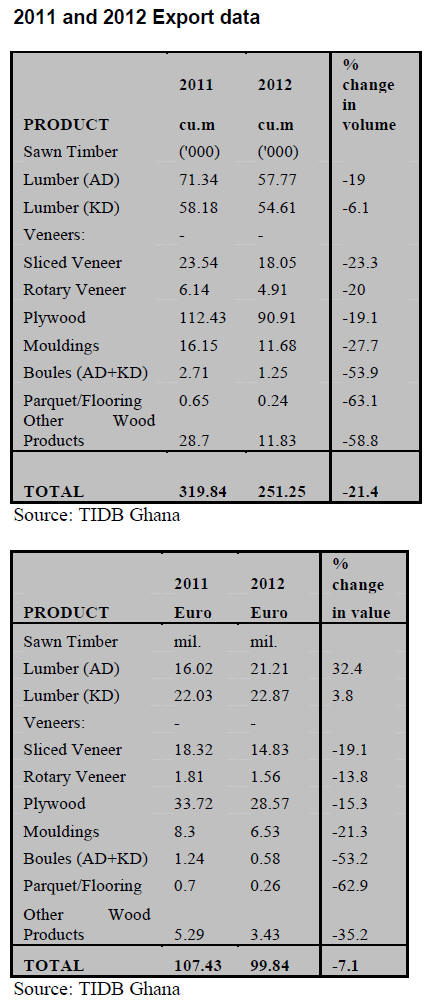
The data indicate that the contribution of primary
products, secondary products and tertiary products to 2012 export volumes
was 4.32%, 90.70% and 4.98% respectively.
For the first time it was observed that African countries were the major
destinations for Ghana¡¯s wood products exports.
Total exports to various African countries earned Ghana euro 38.37 million
from a volume of 140,190 cubic metres.
The ECOWAS market, compromising Nigeria, Niger, Burkina Faso, Togo, Benin
and Mali accounted for 71% of the exports to African countries. The main
products exported to these countries were plywood and sawnwood.
Ghana¡¯s export of wood products to Europe accounted for 20% of all exports.
Markets in the Middle East and Far East accounted for 19% and the N.
American market accounted for just 4.4% of all exports.
New central bank governor appointed
Mr. Henry Kofi Wampah has been appointed as governor of the central bank,
elevating him from the deputy position he held for four years. Mr. Wampah,
replaces Kwesi Amissah-Arthur who is now Ghana's Vice-President.
The new central bank chief said, he stands ready to vigorously defend price
stability and will work to bring inflation back to single digits by
mid-year. Ghana¡¯s annual consumer inflation rose to 10.40% in March from
10.00% in February.
Agro Forestry Tree Planting
A workshop to promote the development of agro-forestry and tree planting was
held recently in Walewale in the Northern Region of Ghana. The forum was
attended by community leaders, assemblymen, farmer's groups as well as women
leaders. The forum discussed the environmental challenges being posed by
desertification and climate change.
The Assistant Training Coordinator of a US based NGO ¡°Trees for the Future¡±,
Mr. George Ansah, explained to participants how agro-forestry technologies
and the planting of fast growing multi-purpose trees could help transform
their lives and solve some of the many challenges they face.
Mr Lovans Owusu-Takyi, Country Director for Trees for the Future and a
Lecturer at the Kumasi Institute of Tropical Agriculture (KITA), in an
interview with the Ghana News Agency, said the NGO is committed to improving
the lives of the people through the development of agro-forestry
technologies. He said tree planting and sustainable management practices
help reduce deforestation.
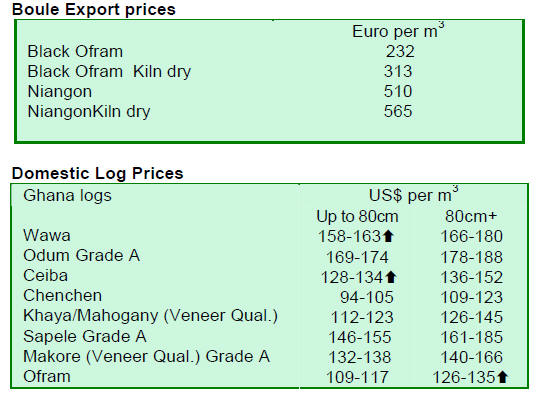

3. MALAYSIA
MIFF such a success exhibitors signing up
for next years¡¯ fair
Tan Chin Huat, chairman of the Malaysian International Furniture Fair (MIFF)
said that exhibitors at last months¡¯ fair reported record orders of RM2.63
billion (approximately US$854 million).
MIFF attracted 18,397 trade visitors of which 6,054 were international
buyers from 140 countries. The sales and visitors figures were considered
very encouraging in view of current global economic uncertainties.
The MIFF was such a success that 70% of the exhibitors who participated in
the recent fair have confirmed their participation in the next MIFF planned
for March 2014. Tan said these are mostly Malaysian companies eager to
increase exports.
MIFF, an annual fair held in Kuala Lumpur for export furniture, is the
second largest furniture fair outside China and widely respected as a
leading show in Southeast Asia. The five day event this year had 504
exhibitors, of which 343 were Malaysian and the rest from 11 countries.
The MIFF 2013 attracted a good turnout of buyers from new markets as well as
from the traditional markets of Australia, Japan and the United States.
The fair covered 80,000 sq.m of exhibition space. MIFF is owned by UBM Asia
which also runs Furniture China in Shanghai, Index Fairs in India and UK
Interiors.
Domestic market remains quiet as general election approaches
Plywood mills are reporting low log stocks. It is perhaps fortunate as the
domestic plywood market is very quiet.
Most manufacturers say the domestic market is not expected to bounce back
any time soon and they expect the current market conditions to last another
3 ¨C 6 months.
Some are hoping for increased sales after the Malaysian general elections
though most say it is difficult to predict how the market will react after
what could be a very tight run race in the election.
Domestic plywood prices:
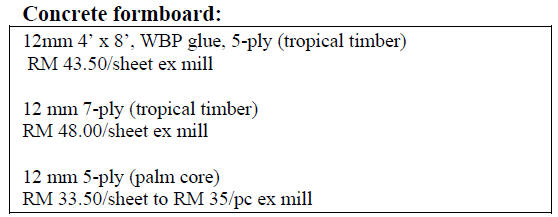
Sarawak mills indicate that export FOB prices for
plywood (MR BB/CC) are 2.7 mm US$550 per cubic metre and US$445-450 for 9 mm
& up.
Sarawak export log prices are reportedly holding steady in light trading.
TTF views on marine ply a thorny issue for Malaysian exporters
Plywood exporters to markets in EU are currently deeply concerned about
marine plywood certification.
Problems surfaced in 2012 over the quality of marine plywood which prompted
the UK Timber Trade Federation (TTF) head of technical and trade policy, to
say it was not sufficient for buyers to rely on the marking marine ply.
He further said ¡°merchants and those further down the supply chain needed to
ask questions and check products properly, specifying and asking for
evidence of marine plywood adhering to BS 1088:2003 (Marine Plywood)¡±.
For more see:
http://www.ttjonline.com/news/marine-ply-concerns-prompt-new-ttf-guidance-note
The National Panel Products Division of the UK TTF advised members not to
buy marine plywood which does not have third party verification of the
British Standard 1088:2003.
This issue has been discussed for a long time and trade analysts say that UK
importers are buying Malaysian marine plywood but selling it to end-users
other boat/ship builders.
It appears that the marine ply is being sold mainly for use in buildings and
exporters point out that, for these end-uses, the plywood need only be CE
Marked.
Plywood exporters mull diverting exports to less demanding markets
Many Malaysian producers report that EU and other overseas buyers are not
willing to pay a higher price for third party verified marine plywood.
Analysts have gained the impression that when UK importers of plywood begin
to call for compulsory third party certification in June this year Malaysian
plywood exporters could divert sales to markets in the Middle East, India,
Japan and South Korea as these countries do not require additional
certification for marine plywood.
Sabah exports
The authorities in Sabah recently released cumulative export statistics for
January and February 2013:

Timber industry expects business as usual during
elections
The Malaysian Prime Minister has dissolved the Federal Parliament in
preparation for the country¡¯s thirteenth general election, scheduled for 5
May 2013. Everyone anticipates this could be one of the most hotly contested
elections in the country¡¯s history.
Apart from federal elections, all States, except Sarawak, will also be
electing state governments. While the public are focused on the elections
the timber industry expects to carry on business as usual.
5th FLEGT expert meeting held in Malaysia
The EU FLEGT Facility Newsletter for February / March 2013 reports that the
Government of Malaysia and the EU met for the fifth Joint Experts Meeting in
early March to discuss technical details of a Voluntary Partnership
Agreement.
The main focus of the meeting was Sabah¡¯s
revised timber legality assurance scheme (TLAS). The authorities in Sabah
had revised the TLAS and further revisions were discussed.
The revised TLAS for Peninsular Malaysia and that for Sabah as well as the
public disclosure documents for Sabah were presented at the 11th National
Stakeholder Consultation in Kuala Lumpur on 28 March, says the EU
newsletter.
It was at this time that the Secretary General of the Ministry of Plantation
Industries and Commodities, Nurmala Abdul Rahim, announced the formation of
a MYTLAS Advisory Group.
The MYTLAS Advisory Group includes representatives from civil society, the
timber trade and industry, forestry experts and key implementing agencies.
All stakeholder consultation reports and MYTLAS documents are available
online at the Ministry of Plantation Industries and Commodities¡¯ dedicated
FLEGT-VPA website for Peninsular Malaysia.
Stakeholder consultation documents for Sabah will be made available on
Sabah¡¯s FLEGT website when launched, says the EU newsletter.
4. INDONESIA
17,000 SVLK certified export shipments
The latest statistics from the Indonesian Timber Legality Information System
(SILK) quoted by Dwi Sudharto of the Ministry of Forestry (MoF) indicate
that 17,121 export documents submitted in compliance with the timber
legality assurance system (TLAS) have been approved to-date by the Indonesia
National Single Windows (INSW).
The documents cover trade to 134 countries worldwide of which 25 are EU
member states (see table below).
Export documents approved 17,123
Destination of exports 134 countries
Destinations in the EU 25
Variety of products (By HS code) 33
Ports of shipment 51
Ports of discharge 633
Source: MoF data
Fourteen verification bodies nationally accredited
During the IFFINA exhibition in Jakarta Dwi Sudharto of the MoF reported
that the number of verification bodies accredited by the Indonesian National
Accreditation Body (KAN) providing SFM audits totals 14.
The number of verification bodies providing SVLK audits for manufacturers
totals 11. (see below)

According to data provided by MoF, as of 4 March
2013 a total of 91 companies with operations in natural forests and
plantations had secured SFM certification.
In addition a total of 35 companies and 14 community forests had secured
legality verification certificates.
The number of manufacturers with SVLK certificates was reported as 383. (see
table below).

NGOs call for reassessment of proposed new
forestry law
A proposed new law which will give the Indonesian MoF greater authority to
address illegal felling is attracting strong criticism from NGOs who fear
the bill could be result in indigenous communities being denied access to
the forest resources required for their daily life.
Environmental groups have called for a reassessment of the wording in the
proposed new law to safe guard the rights of indigenous communities. The
Indonesian Forum for the Environment (Walhi) has estimated that currently
there are around 33,000 villages close to or within forests and the
inhabitants of these villages depend on the forest.
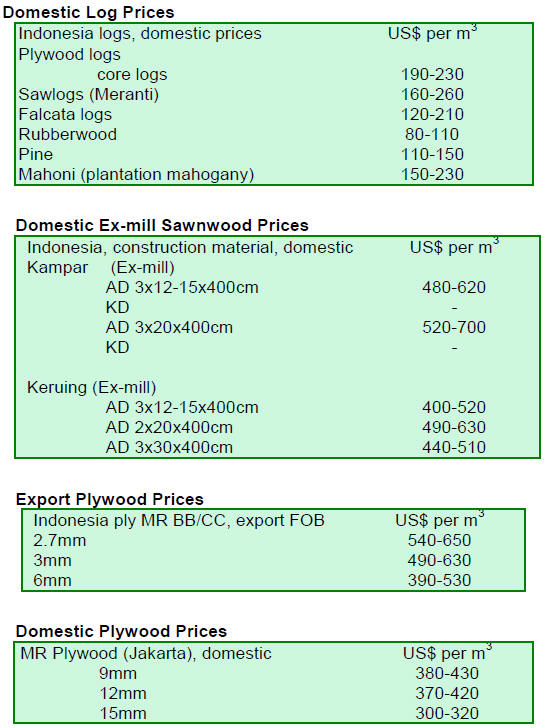
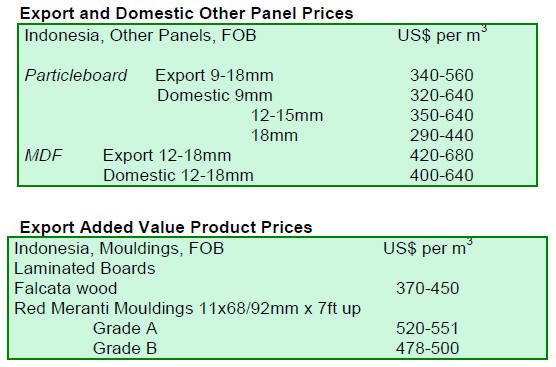
5. MYANMAR
Premium prices being paid for teak logs as
export ban approaches
April marks the beginning of a new fiscal year in Myanmar and Myanmar¡¯s
official New Years¡¯ Day also falls during this month.
The New Year holidays disrupt timber production and harvesting and milling
operations cease for around 15 days.
Analysts say large domestic stockists have already started accumulating teak
logs as the count-down for the log export ban has started.
These stockists are paying premium prices to secure logss anticipating a
surge in demand as teak logs disappear from the international market. It is
an advantage that teak is one of the most durable species and can be stored
for years.
Analysts say that fiscal 2013-14, which started on 1st April 2013, will be
very interesting as the timber sector adjusts to the log export ban.
Already overseas log dealers have begun securing log quotas from local
logging contractors so as to be sure to have adequate stocks.
It appears that teak prices will reach new highs in advance of the log
export ban. The Myanma Timber Enterprise is expected to easily achieve its
export earnings target for this year.
Illegal logging surges in conflict areas
A prominent domestic journal, the Weekly Eleven reported in its 3rd April
issue that illegal loggers are taking advantage of the volatile situation
between the Kachin and the Myanmar Army to harvest, transport and sell large
quantities of timber in a neighbouring country.
The local press reports local people as saying the extent of illegal felling
and logging has increased since the conflict started in 2011.
The quantity of illegally removed timber is estimated by the analysts to be
hundreds of thousands of tons.
One analyst said that the availability of cheap illegal timber has a
negative impact on legally imported timber in China and prices for timber
imported legally have been seriously undermined.
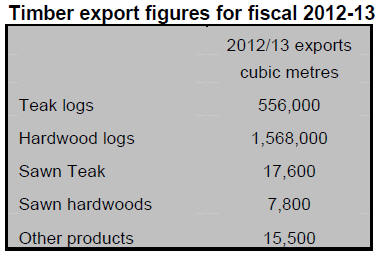
The following average teak prices were recorded
during the March 22 and 25 sale.

¡¡
6.
INDIA
Timber imports help Jammu and Kashmir
conserve forests
In a bid to conserve state forest resources the Jammu and Kashmir government
has adopted policies liberalising the procedures for timber imports and out
of state purchases by manufacturers. At the same time the authorities are
enforcing measures to combat illegal felling.
These measures, claim state authorities, has drastically reduced the illegal
logging in the state.
Private companies sourcing timber from outside the state or from abroad have
to only secure registration at Lakhanpur, the entry point to Jammu and
Kashmir.
From 2009 to 2013, manufacturers in the state utilised around 14.7 million
c.ft of timber from sources outside the state (imported timber and timber
from other states) and 1.2 million c.ft.of timber harvested within the
state.
The forestry minister for the state of Jammu and Kashmir explained that the
state has suffered serious forest degradation due to illegal felling and
increased forest clearing for cattle farming.
The extent of forest loss became so severe that the government implemented
afforestation and conservation projects on a massive scale.
The state has adopted a policy of "planting 100 trees for every 50 trees
felled¡± said the minister. The main focus of the state government is on
protection of forest land, the import of timber to satisfy domestic demand
and increased tree cover to counter soil erosion.
Mangroves stabilize coastlines
In an effort to keep forest land free from encroachment the forest
department, with the consent of the local fishing community, has started
work on regenerating mangrove forest on bare patches and along creeks in
four areas across Mumbai Harbour. Mangrove forests extend over an area of
1,182 ha. around Mumbai.
Sales of Teak and other hardwoods from Indian forests
Auction sales of approximately 3000 cubic metres of teak and other hardwoods
were concluded at government forest depots in Rajpipla and at depots in
Western India. For fresh log lots prices were higher but prices for logs
which had been felled some time ago prices were cheaper than even at
previous sales. Average prices for the latest sales are shown below.
Average prices during the recent auction are shown below. Prices are per
cubic foot ex depot.
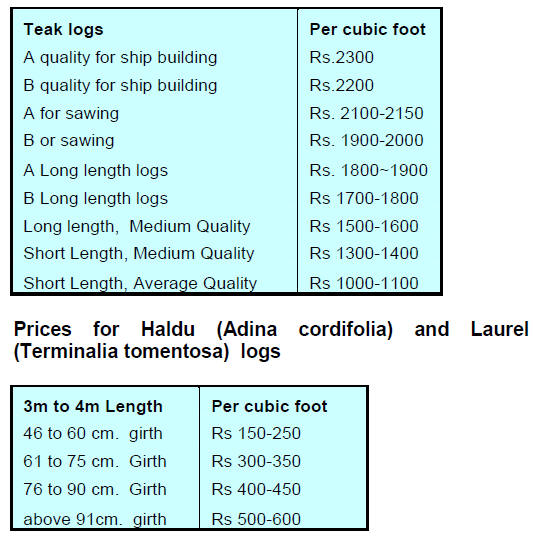
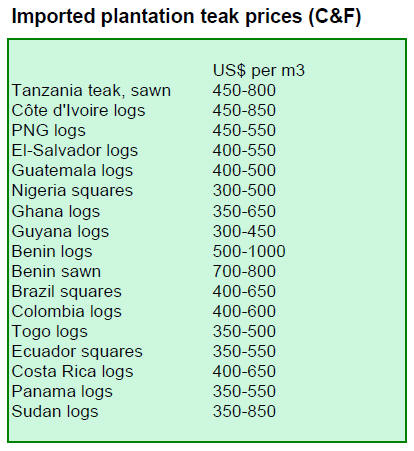
Variations are based on quality, lengths of logs
and the average girth of the logs.
Ex-sawmill prices for imported hardwoods
Prices for air dried sawnwood per cubic foot, ex-sawmill are shown below
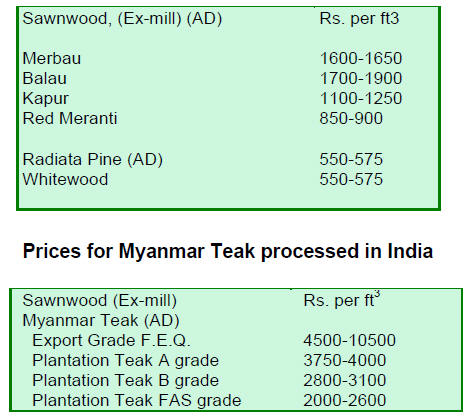
The price range is the result of variations in
length and cross section.
Substitution of teak with other durable tropical hardwoods continues because
of the high price of Myanmar teak.
Imported (KD 12%) sawn wood prices per cft ex-warehouse
Prices remain unchanged.
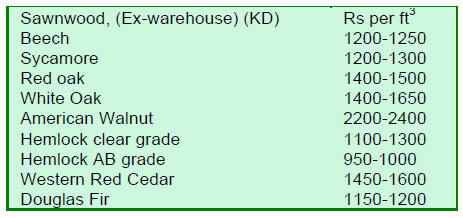
Construction of new homes in satellite towns is
supporting production by plywood mills
Housing sales in the urban areas have slowed compared to last year. Builders
complain that there are too many procedures and license formalities that
must be satisfied before new projects can begin. Also, stamp duty, VAT and
other taxes deter prospective house buyers.
Encouraging developments have been reported in satellite city housing
development. Prices of homes in satellite towns are lower than in the main
urban areas, home owners get larger house plots, there are wide open
recreational areas and fewer traffic problems.
The recently introduced tax exemption on new home loans up to Rs.2.5 mil.
has provided an opportunity for individuals to invest in real estate in the
new towns and demand from this sector of the housing market is supporting
plywood manufacturers and other segments of the timber industry.
Plywood prices remain unchanged after the recent increases and are as shown
below.
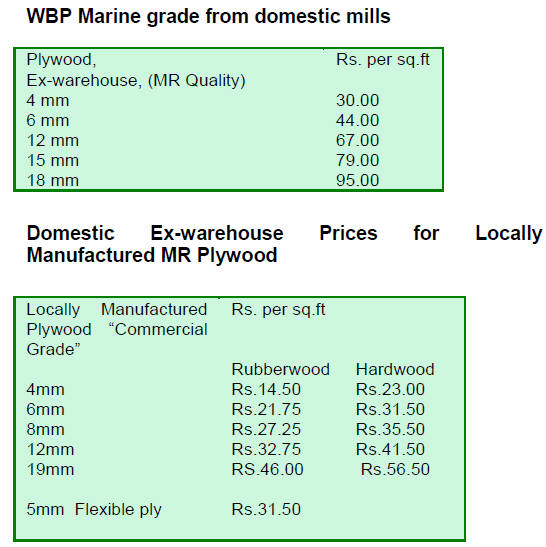
¡¡
7.
BRAZIL
Brazilian forest tracking system
introduced to enterprises
A discussion on tracking and monitoring the origin and movement of forest
products and the relationship between entrepreneurs and the various
Brazilian inspection agencies was recently arranged by the Par¨¢ State
Federation of Industries (FIEPA).
The meeting brought together representatives of the Brazilian Institute of
Environment and Renewable Natural Resources (IBAMA), the State Secretariat
of the Environment (SEMA), forestry companies who are associated with the
Timber Exporter Industries Association of Par¨¢ State (AIMEX) and the Union
of Veneer and Plywood Industry (SINDIMAD).
During the meeting, IBAMA outlined the Brazilian Forest Tracking System
which provides a means to verify the origin of logs. Through the system it
is possible to monitor forest concession output and production. The system
also provides a means to assess social, environmental and economic impacts
and to ensure the protection and integrity of public forests.
FIEPA pointed out that the commitment to develop enforcement mechanisms
should be matched by efforts to improve the profitability and long term
feasibility of timber production.
In response IBAMA explained that it is working with SEMA to ensure that
companies that have been audited will not be hampered in conducting their
businesses
IBAMA said that in the first phase of audits the agency will only notify
companies of where changes are required and guide them in making
adjustments.
Rio Grande do Sul loses top spot as furniture exporter
The state of Rio Grande do Sul had been leading Brazilian furniture exports
since August 2012. However, in February 2013 the value of furniture exports
manufactured in Rio Grande do Sul slipped to second place behind the state
of Santa Catarina.
In January 2013, Rio Grande do Sul was at the top of the list of exporters
shipping US$11,858,942 equivalent to a 26.6% share of all furniture exports.
However, in February exports from Rio Grande do Sul were US$ 25,937,834,
equivalent to 27.3% of all exports while exports from companies in Santa
Catarina were US$ 26,982,822.
In February, the main markets for furniture from Rio Grande do Sul were
Uruguay, (US$ 3,062,527) followed by the United Kingdom, Peru, Chile and
Colombia.
Exports to Colombia increased by around 50% in February to US$ 1,809,057
according to the Foreign Trade Secretariat (Secex) of the Ministry of
Development, Industry and Foreign Trade (MDIC).
At the national level the value of furniture exports in February increased
to US$97,407,580 compared to US$44,562,856 reported in January. But in
comparison with February 2012, there was a 4% decline in export sales. The
only state that registered a growth in exports compared to last year was
Paran¨¢ state where exports grew 9.3% to US$ 16,906,758.
Argentina remains the main market for Brazilian furniture followed by the
United States and the United Kingdom.
Dynamic and flexible forestry sector overcomes global crisis
An analysis in March 2013 by the Center for Forest Intelligence notes the
remarkable dynamism of the Brazilian timber sector as demonstrated by its
response to the global economic crisis of 2008 and subsequent successes.
The analysis also looks at the trade balance in wood products and notes that
in February 2013 exports of wood and wood products were US$ 151.8 million, a
7.9% increase over the previous month. On the other hand, imports of wood
products in February 2013 were US$ 10.85 million, a 24.5% decline compared
to January.
In the first two months of 2013 wood product exports totalled US$ 292
million, a 1.4% increase compared to the same period in 2012. Wood product
imports in the same period totalled US$ 25 million, 13% below the same
period in 2012. The accumulated trade balance for 2013 is reported as US$
267 million, 3% higher than the same period of 2012.
Today, Brazil¡¯s exports of wood products account for around 2.5% of the
world trade in forest products.
Initial assessment suggest big jump in Amazon deforestation
According to the National Institute for Space Research (INPE), 78 percent of
deforestation in the Brazilian Amazon occurs in the state of Mato Grosso.
Data suggest that out of 615.4 sq. km of deforestation in the Amazon some
319.83 sq. Km occurred in Mato Grosso. Preliminary figures suggest that
deforestation in the Amazon increased 26.5% in 2012 compared with 2011.
However, the Institute of Environment and Renewable Natural Resources (IBAMA),
says the extent of deforestation in the Amazon cannot be confirmed because
the system used to assess deforestation, the Real Time Deforestation
Detection System, includes ¡°forest degradation¡±.
IBAMA has advised that only when the results of the PRODES (Program to
Calculate Deforestation in the Amazon) become available in July will it be
possible to have an accurate assessment of deforestation.
The last PRODES survey conducted from August 2011 to July 2012 reported that
4656 km² were deforested in the Amazon.

8. PERU
Disney buys carbon credits in Peru
The Disney Company has reportedly purchased US$3.5 billion in carbon credits
generated by the Alto Mayo Protected Forest (San Martin), home to 23 species
of flora and fauna in danger of extinction.
Pedro Gamboa, head of Peru¡¯s National Service for Protected Natural Areas (Sernanp),
told a local newspaper that this is the first experience of sale of carbon
credits the Peruvian state. Indications are that the price of a carbon
credit in the open market is currently around US$1, but Disney paid
considerably more.
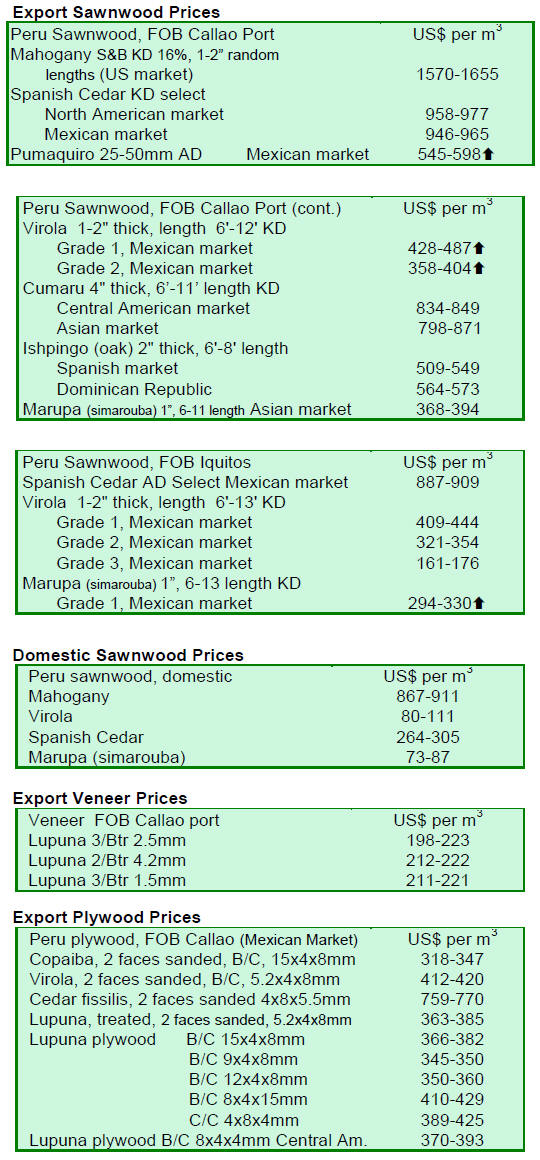
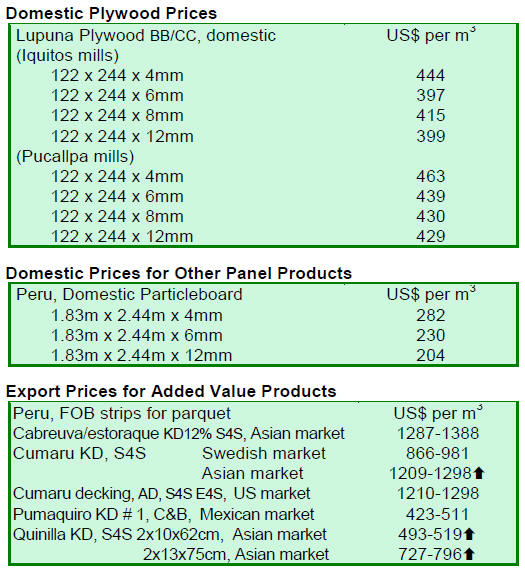
9.
GUYANA
No greenheart log exports for 4 weeks
There were no exports of greenheart logs in the period reviewed and this is
a full 4 weeks without export of greenheart. However, purpleheart logs were
exported at good prices for all qualities.
Standard sawmill purpleheart logs were trading at a high of US$385 per cubic
metre FOB, while prices for fair sawmill quality purpleheart logs were
US$300 per cubic metre FOB. Small sawmill quality purpleheart logs were also
exported and the recorded prices were in the region of US$250 per cubic
metre FOB.
There was moderate export demand for mora logs and attractive prices were
secured.
Sawnwood export prices remain attractive
Despite the rather quiet demand in export markets for logs sawnwood exports
made a notable contribution to overall export earnings as attractive prices
were obtained.
Sawn Undressed greenheart (select) prices improved compared to levels
recorded recently moving from US$855 to US$975 per cubic FOB. Undressed
greenheart (merchantable) quality export prices in the period reviewed were
US$594 per cubic metre FOB.
Undressed Purpleheart (select) sawnwood average prices fell rather sharply
in the period reviewed fro US$1,993 to US$ 1,080 per cubic metre FOB.
However, analysts say this price is considered favourable for sawn
purpleheart.
Undressed purpleheart sawnwood of (sound) and (merchantable) qualities
attracted encouraging export prices of US$575 and US$650 per cubic metre FOB
respectively.
Undressed Mora (select) sawnwood prices were encouraging, rising as high as
US$672 per cubic metre FOB.
Dressed Greenheart sawnwood top end prices climbed a little higher during
the period reviewed moving from US$1,124 to US$1,150 per cubic metre FOB.
In contrast FOB prices for Dressed purpleheart remained unchanged at an
average of US$1,102 per cubic metre.
Guyana¡¯s Ipe (Washiba), a highly durable timber continues to be in high
demand and a major export revenue earner for Guyana. Recent prices were as
high as US$2,275 per cubic metre FOB in the North American market.
Steady demand for processed products in Caribbean and US markets
Some of Guyana¡¯s lesser known species were exported to destinations
including Asia, the Caribbean, Europe and North America. Exports of logs and
sawnwood attracted fairly good prices.
Plywood export prices remain steady at an average of US$584 per cubic metre
FOB.
In the period reviewed greenheart piling was exported at good prices in the
region of US$356 per cubic. Guyana splitwood (shingles) are a regular
feature of the export trade with Caribbean countries.
Value Added products also contributed to the export earnings. In
particularly exports of doors and windows utilising some of Guyana¡¯s top
commercial species such as purpleheart and crabwood (Andiroba) were
encouraging.
Guyana team visits India
The purpose of a visit to India by a team from Guyana was to meet with
Indian manufacturers of plywood, blockboard, doors and furniture and to
promote Guyana¡¯s hardwoods The team also examined Indian made specialized
and cost effective wood processing machinery; examined wood processing and
other industrial machinery during the Indian Engineering Sourcing Show in
Mumbai; encouraged Indian industrialist to invest in the wood processing
sector in Guyana and assessed the export market in India for Guyana¡¯s
hardwoods.
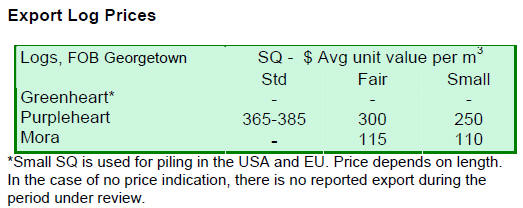
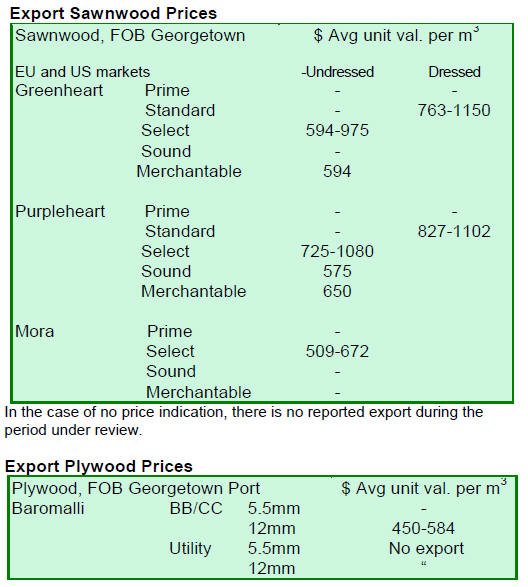
¡¡